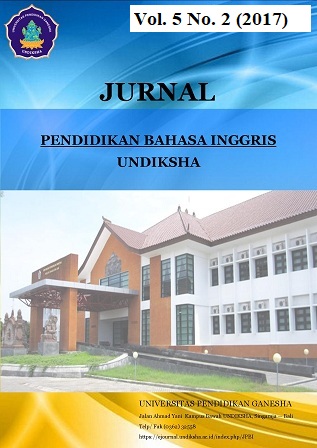AN ANALYSIS OF AMBIGUITY IN ONLINE RECIPES
DOI:
https://doi.org/10.23887/jpbi.v5i2.13390Abstract
Penelitian ini adalah deskriptif kualitatif yang bertujuan untuk menganalisa jenis kata yang ambigu secara leksikal, jenis kata yang ambigu secara rujukannya, dan jenis kalimat atau frase yang ambigu secara struktural yang terdapat di resep online http://www.bonappetit.com. Selain itu, penelitian ini juga bertujuan untuk menemukan ambigu yang dominan yang muncul pada resep online. Subjek dari penelitian ini adalah 20 resep yang terbit pada edisi bulan Januari 2017 sampai Mei 2017. Instrument penelitian ini terdiri dari peneliti dan buku catatan. Data di kumpulkan melalui studi kepustakaan. Data dianalisa menurut ambiguity theory oleh Kriedler (1998). Kemudian peneliti menampilkan hasil analisis dalam bentuk data diskripsi dan presentase. Hasil dari analisis mengungkapkan bahwa terdapat 34 kata dan frase yang ambigu yang terdiri atas 9 ambigu leksikal (26,47%), 2 ambigu rujukan (5,88%), dan 23 ambigu struktural (67,64%). Ambigu struktural muncul sebagai jenis ambigu yang paling dominan dalam resep online http://www.bonappetit.com.Kata Kunci : ambiguitas, ambigu leksikal, ambigu rujukan, ambigu struktural
This was qualitative research design which aimed at analyzing the types of ambiguity namely lexical ambiguity, referential ambiguity and syntactic ambiguity that occurred on the online recipes at http://www.bonappetit.com. Besides, the current study also identified the most dominant ambiguity that was found on the online recipes at http://www.bonappetit.com. The subjects of the study were 20 online recipes within five months editions from January 2017 until May 2017. The instruments of the study were the researcher and note. The data were collected by applying the documentary method. The data analysis was conducted by using ambiguity theory proposed by Kriedler (1998). The data were presented by data description and percentage. The result of the study shows that there are 34 total occurrences of ambiguity. The lexical ambiguity occurs 9 times (26,47%). Then, the referential ambiguity occurs 2 times (5,88%). Moreover, the syntactic ambiguity occurs 23 times (67,64%). It obviously shows that syntactic ambiguity is the most dominant ambiguity on the online recipes at http://www.bonappetit.com.
keyword : ambiguity, lexical ambiguity, referential ambiguity, syntactic ambiguity
Published
2018-02-22
Issue
Section
Articles
License
Authors who publish with the Jurnal Pendidikan Bahasa Inggris Undiksha agree to the following terms:- Authors retain copyright and grant the journal the right of first publication with the work simultaneously licensed under a Creative Commons Attribution License (CC BY-SA 4.0) that allows others to share the work with an acknowledgment of the work's authorship and initial publication in this journal
- Authors are able to enter into separate, additional contractual arrangements for the non-exclusive distribution of the journal's published version of the work (e.g., post it to an institutional repository or publish it in a book), with an acknowledgment of its initial publication in this journal.
- Authors are permitted and encouraged to post their work online (e.g., in institutional repositories or on their website) prior to and during the submission process, as it can lead to productive exchanges, as well as earlier and greater citation of published work. (See The Effect of Open Access)













